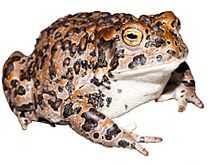Yosemite toad
| Yosemite toad | |
|---|---|
 | |
| Adult female in Kings Canyon
Photo courtesy Paul Maier | |
| Conservation status | |
| Scientific classification | |
| Kingdom: | Animalia |
| Phylum: | Chordata |
| Class: | Amphibia |
| Subclass: | Lissamphibia |
| Order: | Anura |
| Suborder: | Neobatrachia |
| Superfamily: | Hyloidea |
| Family: | Bufonidae |
| Genus: | Anaxyrus |
| Species: | A. canorus |
| Binomial name | |
| Anaxyrus canorus Camp, 1916 | |
 | |
| Synonyms | |
|
Bufo canorus | |
The Yosemite toad (Anaxyrus canorus, formerly Bufo canorus) is a species of true toad in the family Bufonidae (Anaxyrus is a genus of toads distributed across North America). Endemic to the Sierra Nevada of California, the species ranges from the montane forests of El Dorado County near Lake Tahoe south to subalpine Fresno County near Tehipite Valley in Kings Canyon. Yosemite toads show a narrow elevational distribution from 6,200 feet to 11,300 feet. They are the most sexually dichromatic anuran in North America, with males and females displaying strikingly divergent patterns and coloration at maturity. Adult toads are long-lived with upper age limits estimated from 15–20 years, likely an adaptation to their seasonal, high-elevation environment. Yosemite toads have declined substantially in distribution and abundance across their restricted range, and are IUCN endangered, soon-to-be ESA threatened, and are a California species of special concern.
Ecology
The Yosemite toad utilizes montane meadows, sub-alpine meadows, riparian areas and the surrounding forest matrix as critical habitat during the various stages of its life history. They are explosive breeders, migrating to breeding pools and flooded areas in late spring while snowbanks still veil the frozen meadows. Males intermittently give an advertisement call from pool margins, under logs, or inside willows to attract females. Their specific name, canorus (meaning "melodious"), reflects the tuneful and pleasant sound produced by this species. When females arrive they are immediately amplexed by one or multiple males as they fight for a limited number of mating opportunities. Breeding sex ratios can be very skewed toward males (10:1) since females may breed infrequently (every 2–4 years). While being amplexed, females will hop around for several days and lay one or more clutches of 1,000 to 10,000 eggs, which are strung together and resemble two black pearl necklaces in a helical structure. Females remain for several days, males for several weeks.
References
- ↑ Geoffrey Hammerson, Rob Grasso, Carlos Davidson (2004). "Anaxyrus canorus". IUCN Red List of Threatened Species. Version 3.1. International Union for Conservation of Nature. Retrieved October 3, 2011.
